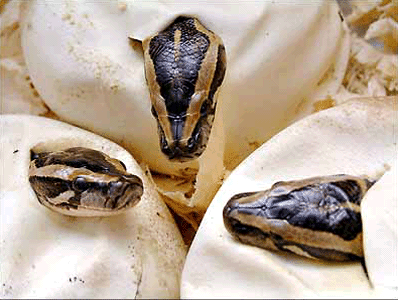Pythons Devastating the Everglades
Pythons are battling alligators for the position of top predator in Everglades National Park in Florida, and native mammals are paying the price, according to a new study by two Florida university researchers. The study is the first to provide evidence linking a sharp decline in populations of medium- and large-sized mammals in the park to an explosion in the number and range of the large snakes.
Native to Southeast Asia, the python is classified as an invasive species in North America. From 1999 to 2004, pet exporters met a growing American demand for Burmese pythons by shipping more than 144,000 baby snakes to the United States. However, new owners were frequently unprepared or unwilling to care for the grown snakes, which can measure 23 feet (7 meters) in length and weigh 200 pounds (91 kilograms). Many owners dumped their snakes into the wild. Pythons released into the Florida Everglades, a region with a climate similar to that of the snakes’ native habitat, flourished. Pythons also have escaped into the wild during hurricanes.
The study’s researchers surveyed native mammal populations over 313 nights during an eight-year period by counting live and dead animals along a road that runs to the southern tip of the park. They then compared their tallies to population surveys done in 1996 and 1997. In areas of the Everglades where pythons have lived the longest, populations of raccoons had fallen by 99.3 percent. The number of opossums had dropped by 98.9 percent, and bobcat populations had fallen by 88.5 percent. The researchers were unable to find any rabbits or foxes. Populations of native animals were larger in areas more recently or not yet invaded by the snakes.
The U.S. Association of Reptile Keepers disputed the findings of the study. The organization contended that mercury pollution in the Everglades has played a major role in the disappearance of the mammals.

Young Indian pythons hatch from eggs outside the mother's body. The leathery shells of snake eggs expand as the young snakes grow inside. When they are ready to hatch, young snakes slash their shells with a special tooth that grows on the upper jaw. AP/Wide World
Wildlife experts agree that eliminating the secretive and hard-to-hunt snakes from the park would be impossible. They are unsure if the spread of the snakes, which have no natural predators in North America, can be halted. In January, the administration of President Barack Obama outlawed the import and interstate commerce of Burmese pythons, two other pythons, and the yellow anaconda. Reptile importers are still allowed to trade in reticulated pythons and boa constrictors.
Additional World Book articles:
- Ecology
- Invasive Species (A Special Report)
- Reptile


